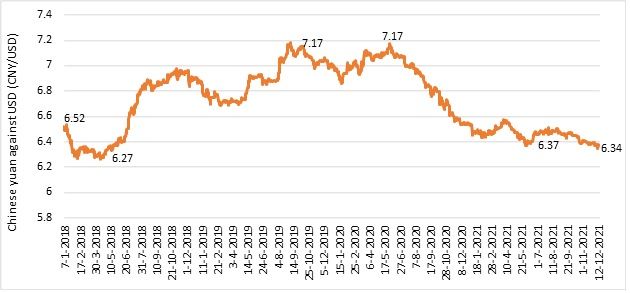Yuan's current appreciation may possibly be short-lived
Yuan, the Chinese currency, may not remain as strong as it has been, going forward. Even if the economy recovers well, exports pressure will likely make the central bank intervene in the currency market, writes Janak Priyani
It is a plain economic fact that investors flock towards assets which provide the highest risk-adjusted returns. When we look at the global currency markets, the safest asset (not necessarily with the highest return) over a long period of time has been the US dollar (USD), which is backed by the Federal Reserve and relatively stronger economic fundamentals. Investors move towards other currency assets when the overall risk-adjusted return from these is higher than the USD. How we have seen the Chinese yuan appreciate tremendously over the last year is not surprising at all, as the Chinese economy recovered exceptionally well.
Chinese yuan strengthened from 7.17 against USD in June 2020 to 6.37 by the beginning of June 2021. The multi-year decline in value reached in May/June 2020 was predominantly due to investors looking to safeguard their money and parking them in USD and other relatively safer assets. From then on, the Chinese economy revived sharply, with consumer demand and economic activity picking up robustly. The three quarters until September 2021 averaged a GDP growth of 14.9 per cent y-o-y and retail sales in China have seen an average of 16.4 per cent y-o-y growth until October 2021.

Source: TexPro
The investment sentiment towards China until the third quarter was also highlighted by global capital flows to China. Global FDI inflows to China reached $142 billion by the end of October 2021 (YTD), growing by 23.4 per cent in dollar terms over last year. This also supported the strengthening of yuan as the global supply chains reopened and trade flows from China continued to flow unabatedly.
What has been more interesting is the continued strength of the Chinese currency in recent months even when uncertainty about the economy has shot up. During the last five months, Chinese economy was struck by the toughest of typhoons, renewed surge of coronavirus infections, power curbs due to increasing pollution, and a real estate market contraction that market experts worried could be worse than the Lehman Brothers’crisis of 2007-08. Chinese yuan has remained strong since May 2021, except for a brief period of two months when it depreciated slightly. Moreover, it has reached almost historic levels, appreciating to 6.34 CNY/USD, just above the 6.27 level reached in early 2018.
However, experts worry about the sustainability of such a situation because inflation in China, particularly rise in producer prices, has reached multi-year highs, and keeping policy interest rate low to buy time on the real estate market scenario can only be done temporarily. Domestic producer price inflation along with currency appreciation means a double whammy for China’s exports if continued for long. Appreciation increases costs over and above the domestic prices for those importing from China. What has been China’s strength historically is the reasonable cost, quality, and the timely availability of products. Currently, two of the three (cost and timely delivery) could possibly be jeopardised due to the prevailing situation. Notwithstanding, Chinese economy is still fundamentally strong, but capital market risks loom large.
This throws up the next and the bigger problem. The recent real estate market slump began in September 2021 when China’s second-largest real estate developer Evergrande defaulted on debt repayments. Since then, the real estate market woes have only worsened for China, as some other real estate developers have missed debt repayment obligations, while housing sales have declined for the last two months. What appears more disturbing is the likely spillover impact on the entire economy if the situation were to worsen further. Sentiment for manufacturing activity in China has not been positive over the last few months and have almost been contractionary, as indicated by the PMI. China’s manufacturing PMI touched 50.1 in November 2021, after registering 49.2 in October 2021. The future course will depend on how long the policymakers will be able to hold the policy rate low and how much could they dampen the impact of the real estate slump.
Then, the strength of the yuan will likely be clearer in the coming months. Currently, it appears that investors are factoring in a muted impact of real estate market on the overall economy and voting for a turnaround. In either case, yuan may not remain as strong as it has been, going forward. Even if the economy recovers well, exports pressure will likely make the central bank intervene in the currency market.
- Top keywords
- Cotton Price
- Cotton Futures Price
- Cotton Futures
- CZCE
- PTA Futures Price
- Chemical Fiber
- Polyester Prices
- Wool price
- PTA Futures
- Shengze Silk
- China
- Yarn Price
- price
- China Textile City
- Fibre Price
- Benzene Price
- Cotton
- Index
- Cotton Index
- PTA
- fabric price
- NYMEX
- Top 10
- textile industry
- Spot Cotton
- Cotton Yarn
- Polyester Price
- Futures
- PTA Price
- cotton yarn price

